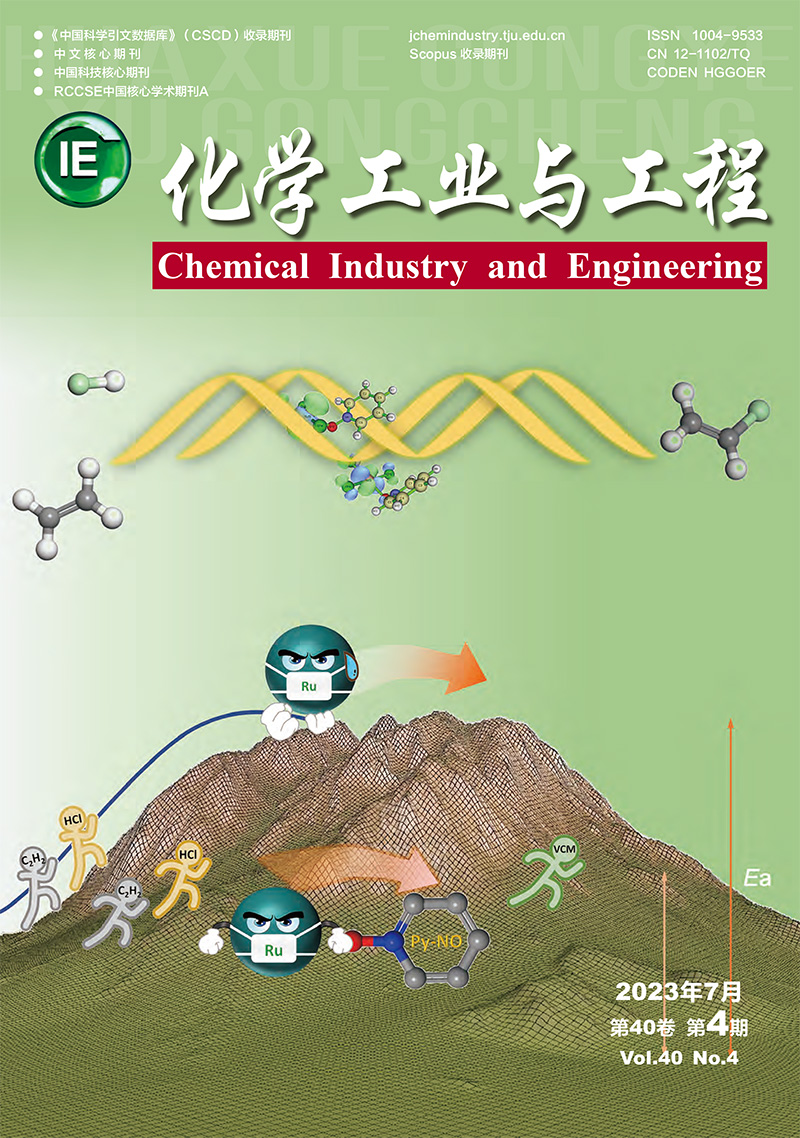2. 天津大学材料科学与工程学院,天津 300350
2. School of Materials Science and Engineering, Tianjin University, Tianjin 300350, China
在我国已探明的油气储量中,低渗透油藏储量的比例很高,约占全国储量的2/3以上,开发潜力巨大[1]。低渗透油田在地质特征上主要表现为渗透率低,该类油田一般处于渗透率相对有限的地质环境中,油层孔隙率不高,促使油田开采效率大幅降低,难以达到普通油田的开采程度[2, 3]。因此,采用合理的驱油方法提高低渗透油藏的采收率是一个不可忽视的重要问题。注水开发是常用于开采低渗透油藏的方法,通过向油层注水,提高油层压力,使得地表层中的大量原油能够被顺利开发出来[4-6]。但随着注水时间的延长,油井含水量不断升高,地层深部压力不断攀升,油田采收率逐步下降。当产水率达到95%~98%时,继续注水是十分不经济的,这时将被迫停止注水,而此时的采收率一般小于40%。仅仅使用注水开发的开采方法已无法满足大量的石油需求,因此聚合物微球驱油技术逐渐进入人们的视线。纳米聚合物微球能够提高驱替相的黏度,扩大波及体积,且制备技术简单、费用较低而受到油田开发技术人员广泛重视,目前已在国内长庆、大庆、胜利和渤海等油田开展工业化推广应用或矿场试验,取得了明显增油降水效果[7-10]。但随着近年来油田进一步开采,对聚合物微球的耐温抗盐性能提出了更高的要求[11],因此制备耐温抗盐非聚丙烯酰胺类新型超分子体系是十分必要的[12]。
在前期实验中,作者通过透过滤膜实验、微通道驱替实验等,对50、100 nm聚合物微球的封堵性能和驱油性能进行了研究,结果显示,在50和100 nm微球的微通道实验中都观察到了微米级别的团聚物,扩大了水分散体系的波及体积,对揭示纳米微球的驱油机理和产品的可持续发展与创新具有显著意义[13]。
近期,作者认为通过微观可视化油滴剥离实验可以更好地探讨聚合物微球的驱油机理。Kirtiprakash等[14]使用二氧化硅纳米颗粒悬浮液进行实验,发现纳米流体在油滴和固体表面之间扩散,形成一层薄的纳米流体膜,这是一条明亮的外接触线,有别于传统的三相外接触线。Sefiane等[15]研究发现,纳米流体的结构分离压力可以促进纳米流体的强制扩散。结构分离压力是由纳米颗粒在限定的三相区域中的固体状排列产生的附加压力。该附加压力受纳米颗粒的尺寸、数量、温度、分散介质的盐度和岩石表面状况的影响。当纳米颗粒的数量达到一定值时,则可以在楔形膜的顶点(有限的三项式区域)产生超过345 MPa的力,这足以影响纳米流体的扩散。进一步研究[16, 17]结果表明,由于结构分离压力,胶束纳米粒子和高浓度二氧化硅纳米流体均能够在油滴和固体表面之间形成预润湿水性薄膜,且水性薄膜不断向内扩大,最终将油滴剥离。Wang等[18]使用粒径约为54 nm的聚丙烯酰胺纳米微球进行微通道、油滴剥离等实验,证明其有较好的驱油性能,并通过实验研究,探讨了结构分离压力对剥离油滴的作用。
鉴于此,本研究选用50和100 nm及油基超分子3种聚合物微球进行对比研究,结合粒径、黏度、毛细管内油水传质行为以及降低界面张力的作用,进一步探究其剥离油滴的作用效果,为筛选效果更好的聚合物驱油体系提供有力的理论支撑。
1 实验材料和方法 1.1 实验材料50和100 nm聚丙烯酰胺微球乳液:中海油渤海油田应用的微球乳液商品。油基超分子微球乳液:中海油田服务股份有限公司天津分公司提供。十二烷基硫酸钠(SDS):天津江天化工有限公司提供。原油:中海油田服务股份有限公司天津分公司提供,油井JZ25-1采出液。
1.2 主要设备与仪器微型注射器、工业数码显微镜,BC、激光粒度分析仪,Nano-ZS90、数显黏度计,NDJ-5S/9S、表面张力仪,OCA15EC、毛细管(0.3 mm)、载玻片、石英盒。
1.3 实验方法 1.3.1 样品制备称量适量十二烷基硫酸钠、微球干粉于烧杯中,加蒸馏水至50 g,使用磁力搅拌30 min、超声30 min得到调驱剂分散体系。
1.3.2 结构表征与性能测试粒度测量:称取少量纳米聚合物微球样品与分散至白油中,配制成5‰微球调驱剂溶液,用磁子搅拌器匀速搅拌30 min,观察微球溶液的状态,当溶液的状态较为均匀时,在室温条件下静置保存1 d。
TEM观察:使用透射电镜电镜观察调驱剂溶液中微球干粉的状态,观察其是否存在微球的缠结、黏连等团聚行为。
黏度测试:使用数显黏度计分别测试驱油体系在不同温度以及不同分散介质的条件下的动力黏度,比较不同体系的水油流度比。
1.3.3 毛细管传质行为研究配制浓度为5‰的调驱剂,并进行实验。首先打开相机与显微镜电源,然后用毛细管先吸取适量调驱剂溶液再吸取适量原油,二者接触1 h后,放置在载玻片上用显微镜观察实验现象。对从油水界面开始对整个调驱剂段进行录像,并观察油滴状态。
1.3.4 界面张力测试使用表面张力仪测试测试在去离子水和中海油服提供现场注入水、在不同水化条件下的不同种类微球的界面张力,进一步分析调驱剂在提高波及效率与驱油效率方面的作用。
1.3.5 油滴剥离实验用移液枪取用原油0.5 μL并滴在载玻片上,并将其倒置放置在调驱剂中。通过放置在油滴上方的显微镜获得原油的俯视图,以监控从表面去除原油的过程。实验温度设置为常温(25 ℃)和高温(65 ℃)。实验示意图见图 1。

|
| 图 1 油滴剥离实验示意图 Fig.1 Schematic diagram of oil droplet peeling experiment |
| |
图 2 (a)、(b)[13]和(c)分别是50和100 nm以及油基超分子微球的粒径图。由图 2可得,油基超分子微球的粒径为1 μm左右。在之前的研究中我们发现,50 nm微球虽然粒径小,容易发生溶胀、团聚行为,而粒径偏大的微球更不易发生团聚行为。
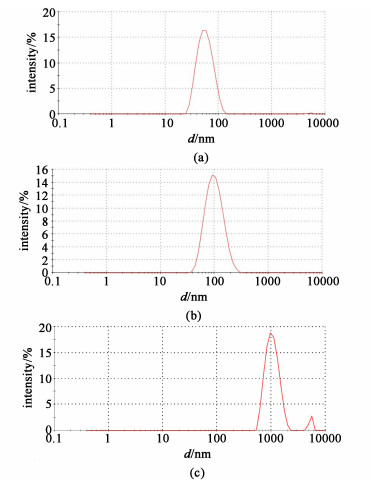
|
| 图 2 粒径图(a)50 nm微球;(b)100 nm微球;(c)油基超分子微球 Fig.2 Particle size diagrams of (a) 50 nm microspheres; (b) 100 nm microspheres; (c) oil-based supramolecular microsphere |
| |
图 3为50 nm微球、100 nm微球与油基超分子微球的透射电镜观察图。50和100 nm微球干粉的透射电镜图显示,微球间极易发生缠结、黏连,但油基超分子微球分散较为均匀,不宜团聚,且由透射电镜图可看出,其粒径在1 μm左右,这与2.1中的测试结果相符。

|
| 图 3 (a) 50 nm; (b)100 nm; (c) 油基超分子微球干粉透射图 Fig.3 Transmission images of (a)50 nm; (b) 100 nm; (c) oil-based supramolecular microsphere dry powder |
| |
表 1是在不同温度和不同分散介质下,3种乳液调驱剂的黏度值。由表 1中数据可得,随着温度升高,聚合物水溶液黏度降低。这是由于分子热运动加剧,温度升高,分子间力减小;同时使得溶剂化程度减小,而克服原子内旋转阻力的能力增加,均使分子链卷曲,黏度降低。当分散介质为注入水时,随着矿化度增加,聚合物黏度降低。这是因为矿化度升高,聚合物分子链卷曲,表观尺寸减小,导致黏度降低。而不论在何种条件下,油基超分子微球乳液的黏度值始终大于50和100 nm微球乳液,在使用同样原油进行驱油时,油基超分子微球与原油的流度比更小,驱替效率更高。
| 分散介质 | 温度/ ℃ | 微球种类 | ||
| 50 nm | 100 nm | 油基CFZ | ||
| 去离子水 | 25 | 2.05 | 2.10 | 19.00 |
| 65 | 1.49 | 1.11 | 2.76 | |
| 注入水 | 25 | 1.15 | 1.09 | 1.25 |
| 65 | 0.96 | 1.00 | 1.15 | |
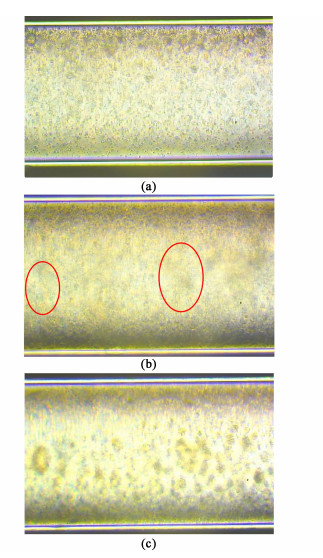
|
| 图 4 毛细管内水油传质行为(去离子水)(a)50 nm微球;(b)100 nm微球;(c)油基超分子微球 Fig.4 Water-oil mass transfer behavior in capillary (deionized water) (a) 50 nm microspheres; (b) 100 nm microspheres; (c) oil-based supramolecular microspheres |
| |
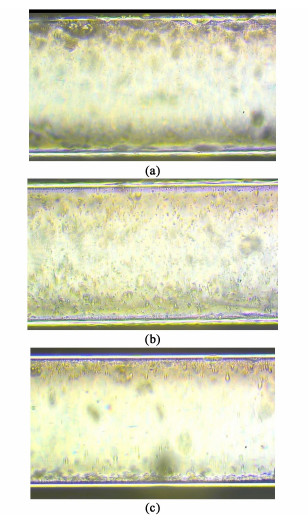
|
| 图 5 毛细管内水油传质行为(注入水)(a)50 nm微球;(b)100 nm微球;(c)油基超分子微球 Fig.5 Water-oil mass transfer behavior in capillary (injecting water) (a) 50 nm microspheres; (b) 100 nm microspheres; (c) oil-based supramolecular microspheres |
| |
比较图 4和图 5可以发现:当分散介质为去离子水时,油基超分子微球实验组出现少量小油滴,而50和100 nm实验组基本无油滴出现;当分散介质为注入水时,油基超分子实验组出现大量油滴,且部分油滴体积较大,而50 nm实验组出现少量油滴;100 nm实验组出现极少量小油滴,且油滴颜色浅。由此现象可知,在调驱剂与原油充分接触相同时间的条件下,油基超分子微球表现出了较好的驱油性能,且当分散介质为注入水时,有较多油滴出现,这证明粒子的运动作用较强,可使较多的小油滴脱落,油基超分子体系表现出了较好的抗盐性。
2.5 界面张力测试表 2是在不同分散介质下,各乳液调驱剂与煤油的界面张力。
| 分数介质 | 数值 | 微球种类 | ||
| 50 nm | 100 nm | 油基CFZ | ||
| 去离子水 | 46.6 | 23.3 | 17.9 | 12.9 |
| 注入水 | 58.1 | 19.7 | 23.4 | 17.1 |
由表 2中数据可得,油基超分子体系具有更好的降低界面张力的作用。油基超分子体系可吸附在油水界面上,形成一层纳微米颗粒膜,从而改善油水界面的性质。在实际应用中,这可使得岩石由油湿向中性润湿状态转变,甚至达到水湿,使得原油更易乳化,从而提高原油产出率。
2.6 油滴剥离实验 2.6.1 SDSSDS是一种常用的表面活性剂,以往的研究表明,SDS可较大程度降低油水界面的界面张力[19]。图 6是油滴剥离初始图,其外轮廓呈不规则形状。图 7和图 8分别是25和65 ℃实验条件下使用SDS进行油滴剥离的实验结果图。25 ℃时,在界面张力的作用下,油滴在5.5 min左右变为圆形,且较快出现外接触线,在结构分离压力的作用下,外接触线不断向内移动,其直径由0.44 mm缩小至0.37 mm。30 min左右油滴被剥离,在调驱剂中游动。而在65 ℃条件下,1 min左右油滴变为圆形,迅速出现外接触线,外接触线直径由0.38 mm缩小至0.26 mm。13 min左右油滴被剥离,在调驱剂中游动。外接触线的移动速度即调驱剂的扩散速度。
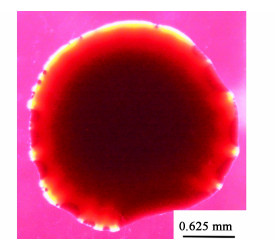
|
| 图 6 油滴剥离初始图 Fig.6 Initial image of oil droplet peeling |
| |
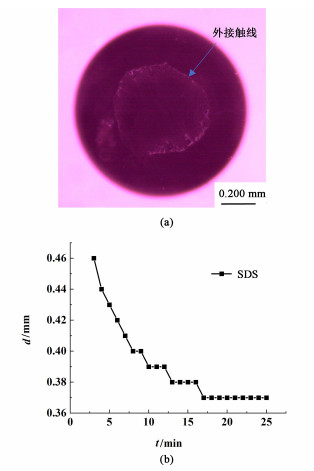
|
| 图 7 (a) 25 ℃条件下SDS油滴剥离俯视图;(b)外接触线随时间移动图 Fig.7 (a) Top view of SDS oil droplet peeling under 25 ℃; (b) time-shifting diagram of the outer contact line |
| |
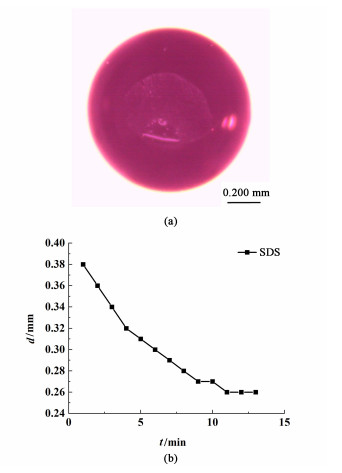
|
| 图 8 (a) 65 ℃条件下SDS油滴剥离俯视图;(b)外接触线随时间移动图 Fig.8 (a) Top view of SDS oil droplet peeling under 65 ℃; (b) time-shifting diagram of the outer contact line |
| |
该组实验作为对照组实验,在接下来的研究中,讨论50和100 nm以及油基超分子微球干粉分别加入SDS后剥离油滴的作用。
2.6.2 50 nm微球干粉+SDS图 9和图 10分别是25和65 ℃实验条件下使用50 nm微球干粉加SDS进行油滴剥离的俯视实验结果图。25 ℃条件下,2.5 min左右油滴变为类圆形,16 min左右被剥离,小油滴在调驱剂中游动。外接触线直径由0.54 mm缩小至0.37 mm。而在65 ℃条件下,外接触线变得不明晰,证明50 nm微球体系耐高温的能力较差。
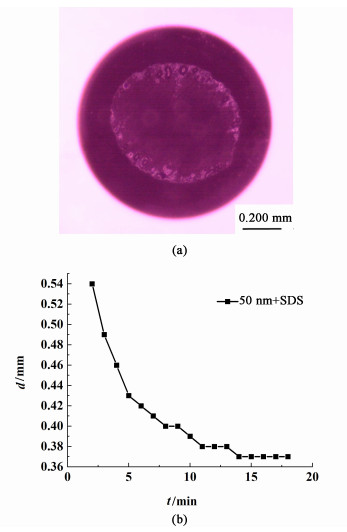
|
| 图 9 (a) 25 ℃条件下50 nm微球干粉+SDS油滴剥离俯视图;(b)外接触线随时间移动图 Fig.9 (a) Top view of 50 nm microsphere dry powder+SDS oil drop peeling under 25 ℃; (b) time-shifting diagram of the outer contact line |
| |
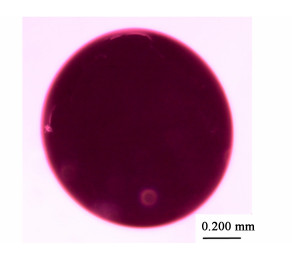
|
| 图 10 65 ℃条件下50 nm微球干粉+SDS油滴剥离俯视图 Fig.10 Top view of 50 nm microsphere dry powder+SDS oil drop peeling under 65 ℃ |
| |
与SDS相比,该调驱剂体系剥离油滴的速度明显提高。这证明SDS与微球干粉有协同作用,因结构压力产生的水性薄膜向内移动的速度变快,最终剥离油滴的时间大幅减少。但在65 ℃条件下,50 nm微球干粉和SDS调驱剂分散体系剥离油滴时的外接触线不明晰,且不呈规则的圆形,可能是因50 nm微球在高温条件下已发生溶胀、团聚,使得调驱剂分散体系稳定性降低,使得油滴受到的结构分离压力不均一,在显微镜下,外接触线变得不清晰。
2.6.3 100 nm微球干粉+SDS图 11和图 12分别是25和65 ℃实验条件下使用100 nm微球干粉加SDS进行油滴剥离的实验结果图。25 ℃实验条件下,13.5 min左右油滴变为圆形,有外接触线产生,外接触线直径由0.65 mm缩小至0.62 mm,移动缓慢,油滴未被剥离。65 ℃实验条件下,2.5 min左右油滴变为类圆形,10 min左右被剥离,小油滴在调驱剂中游动。外接触线直径由0.36缩小至0.26 mm。
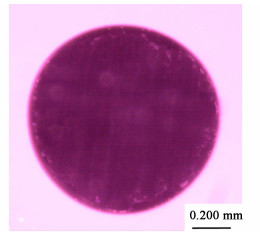
|
| 图 11 25 ℃条件下100 nm微球干粉+SDS油滴剥离俯视图 Fig.11 Top view of 100 nm microsphere dry powder+SDS oil drop peeling under 25 ℃; (b) time-shifting diagram of the outer contact line |
| |
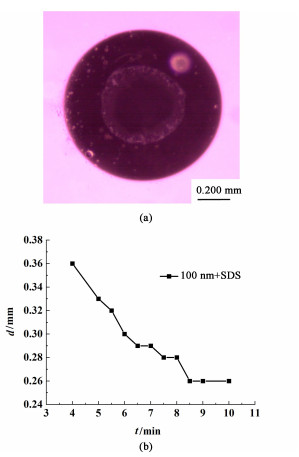
|
| 图 12 (a) 65 ℃条件下100 nm微球干粉+SDS油滴剥离俯视图;(b)外接触线随时间移动图 Fig.12 (a) Top view of 100 nm microsphere dry powder+SDS oil drop peeling under 65 ℃; (b) time-shifting diagram of the outer contact line |
| |
25 ℃实验条件下,100 nm微球体系实验中,外接触线移动缓慢,且无法将油滴剥离,与50 nm微球相比,50 nm微球更易团聚,当粒子达到一定数量时,结构分离压力在受限的三相区域中对的作用更大,因此100 nm微球体系无法将油滴剥离。研究表明[20],在一定的温度范围内(40~120 ℃),原油的黏度会随着温度的升高而明显降低,且降低的幅度较大,这主要是因为温度越高,分子的热运动越剧烈。升高温度使得水油两相的流度比降低,因此在65 ℃实验条件下,原油油滴可被剥离。
2.6.4 油基超分子微球干粉+SDS图 13和图 14分别是25和65 ℃实验条件下使用油基超分子微球干粉加SDS进行油滴剥离的实验结果图。25 ℃条件下,6 min左右油滴开始变为圆形,22 min左右被剥离,小油滴在调驱剂中游动。外接触线直径由0.38缩小至0.30 mm。65 ℃条件下,1 min油滴变为圆形,7 min左右被剥离,小油滴在调驱剂中游动。外接触线直径由0.27 mm缩小至0.19 mm。
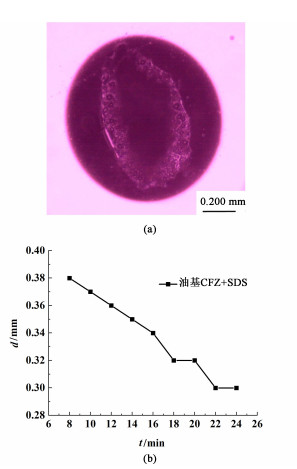
|
| 图 13 (a) 25 ℃条件下油基超分子微球干粉+SDS油滴剥离俯视图;(b)外接触线随时间移动图 Fig.13 (a) Top view of oil-based supramolecular microsphere dry powder+SDS oil drop peeling at 25 ℃; (b) time-shifting diagram of the outer contact line |
| |
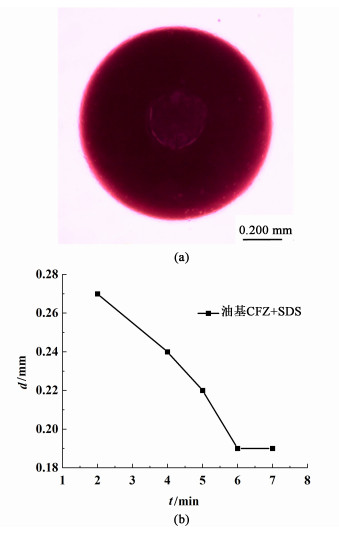
|
| 图 14 (a) 65 ℃条件下油基超分子微球干粉+SDS油滴剥离俯视图;(b)外接触线随时间移动图 Fig.14 (a) Top view of oil-based supramolecular microsphere dry powder+SDS oil drop peeling under 65 ℃; (b) time-shifting diagram of the outer contact line |
| |
表 3是不同微球剥离油滴的时间。由表 3中数据可得,在25 ℃条件下,除100 nm微球,其余2种微球均与SDS有协同作用,在25 ℃条件下,剥离油滴的时间都有所提升,其中,50 nm微球剥离的速度最快;而在65 ℃条件下,100 nm和油基超分子微球体系能将油滴剥离,且其剥离时间与25 ℃条件下相比缩短了一半左右。其中油基超分子微球剥离的速度较快。高温条件下,体系驱油的效果较好,而油基超分子微球体系表现出了较好的耐高温性能。
| 温度/ ℃ | 微球种类 | |||
| SDS | 50 nm+ SDS | 100 nm+ SDS | 油基超分子+ SDS | |
| 25 | 30 | 16 | 22 | |
| 65 | 13 | 8 | 9 | 7 |
(1) 50 nm聚合物微球虽粒径最小,但最易发生缠结、黏连等团聚行为;油基超分子微球粒径在1 μm左右,分散性较好,不易团聚。
(2) 在不同温度、不同分散介质的条件下,油基超分子微球乳液的黏度值始终大于50和100 nm微球乳液,在使用同样原油进行驱油时,油基超分子微球与原油的流度比更小,驱替效率更高。
(3) 油基超分子体系表现出了较好的抗盐性:在毛细管实验中,当分散介质为注入水时,有较多油滴出现,这证明粒子的运动作用较强,可使较多的小油滴脱落。
(4) 相比于50和100 nm微球体系,油基超分子微球体系具有更好的降低界面张力的作用。
(5) 聚合物微球与表面活性剂有协同作用,剥离原油油滴的速度明显变快。
(6) 与100 nm微球相比,50 nm微球的团聚行为使得其在25 ℃实验条件下也可积累较多数量的粒子,可将油滴剥落。65 ℃实验条件下,原油的黏度变小,提高温度使得水油两相的流度比变小,因此高温可明显促进油滴剥离作用。与50 nm微球相比,油基超分子微球体系克服了常规聚丙烯酰胺类驱油剂在高温高盐油藏条件下增黏性和耐温抗盐性较差的不足,是一种非常有前景的且适用于高温高盐油藏的新型驱油体系。
| [1] |
赵防震, 陈英利, 赵鹏. 分析低渗透油田开发与压敏效应[J]. 化工管理, 2018(1): 210-210. ZHAO Fangzhen, CHEN Yingli, ZHAO Peng. Analysis of low permeability oilfield development and pressure sensitive effect[J]. Chemical Management, 2018(1): 210-210. DOI:10.3969/j.issn.1008-4800.2018.01.146 (in Chinese) |
| [2] |
张帆, 马元, 王一航. 低渗透油田地质特征及开发效果改善分析[J]. 化工设计通讯, 2020, 46(6): 56, 60. ZHANG Fan, MA Yuan, WANG Yihang. Geological characteristics of low-permeability oil field and improvement analysis of development effect[J]. Chemical Engineering Design Communications, 2020, 46(6): 56, 60. (in Chinese) |
| [3] |
李淑娟, 张倍铭, 李东林. 国内油层深部液流转向调驱机理及应用现状[J]. 中国石油石化, 2017(6): 2-3. LI Shujuan, ZHANG Beiming, LI Donglin. Mechanism and application status of profile control and flooding in deep oil layers in China[J]. China Petrochem, 2017(6): 2-3. (in Chinese) |
| [4] |
王骏, 杨晓阳. 低渗透油藏注水开发存在的问题与改进措施[J]. 石化技术, 2020, 27(3): 168-169. WANG Jun, YANG Xiaoyang. Problems and improvement measures of water injection development in low permeability reservoirs[J]. Petrochemical Industry Technology, 2020, 27(3): 168-169. DOI:10.3969/j.issn.1006-0235.2020.03.098 (in Chinese) |
| [5] |
李翔, 瞿瑾, 鞠野, 等. 深部调驱用纳米聚合物微球的研究进展[J]. 化学工业与工程, 2021, 38(2): 48-54. LI Xiang, QU Jin, JU Ye, et al. Research progress of nano-polymer microspheres for deep profile control and flooding[J]. Chemical Industry and Engineering, 2021, 38(2): 48-54. DOI:10.3969/j.issn.1006-7906.2021.02.011 (in Chinese) |
| [6] |
PRITCHETT J, FRAMPTON H, BRINKMAN J, et al. Field application of a new in-depth waterflood conformance improvement tool[C]//SPE International Improved Oil Recovery Conference in the Asia Pacific, Kuala Lumpur, Malaysia. Society of Petroleum Engineers, 2003
|
| [7] |
吴天江, 程辰, 宋昭杰, 等. 调驱用纳米聚合物微球分散体系流变性评价[J]. 应用化工, 2021, 50(10): 2695-2698, 2713. WU Tianjiang, CHENG Chen, SONG Zhaojie, et al. Rheological evaluation of dispersion system of nano polymer microspheres for profile control[J]. Applied Chemical Industry, 2021, 50(10): 2695-2698, 2713. DOI:10.3969/j.issn.1671-3206.2021.10.016 (in Chinese) |
| [8] |
孙哲. 聚合物微球油藏适应性评价方法及调驱机理研究[D]. 黑龙江大庆: 东北石油大学, 2017 SUN Zhe. Study on the evaluation method of polymer microsphere reservoir adaptability and the mechanism of control and flooding[D]. Heilongjiang Daqing: Northeast Petroleum University, 2017(in Chinese) |
| [9] |
赵华强, 彭勃. 聚合物微球在油田深部调驱技术中的研究进展[J]. 化工进展, 2021, 40(S2): 75-80. ZHAO Huaqiang, PENG Bo. Research progress of polymer microspheres in deep oil field control and displacement technology[J]. Chemical Industry and Engineering Progress, 2021, 40(S2): 75-80. (in Chinese) |
| [10] |
康万利, 周博博, 杨红斌, 等. 油田调驱用聚合物微球的研究进展[J]. 高分子材料科学与工程, 2020, 36(9): 173-180. KANG Wanli, ZHOU Bobo, YANG Hongbin, et al. Comprehensive review of polymer microspheres for oil field conformance control and flooding[J]. Polymer Materials Science & Engineering, 2020, 36(9): 173-180. (in Chinese) |
| [11] |
CHEN S, LIU W, WANG G, et al. Review of emulsion system in petroleum industry[J]. Applied Chemistry, 2017, 46(7): 1366-1369, 1373. |
| [12] |
徐辉, 曹绪龙, 孙秀芝, 等. 三次采油用小分子自组装超分子体系驱油性能[J]. 油气地质与采收率, 2017, 24(2): 80-84. XU Hui, CAO Xulong, SUN Xiuzhi, et al. Study on oil displacement performance of self-assembled small-molecule supramolecular system for EOR[J]. Petroleum Geology and Recovery Efficiency, 2017, 24(2): 80-84. (in Chinese) |
| [13] |
李翔, 瞿瑾, 鞠野, 等. 纳米聚合物微球的封堵性及驱油性能[J]. 化学工业与工程, 2021, 38(3): 57-63. LI Xiang, QU Jin, JU Ye, et al. Plugging performance and oil displacement performance of nano-polymer microspheres[J]. Chemical Industry and Engineering, 2021, 38(3): 57-63. (in Chinese) |
| [14] |
KONDIPARTY K, NIKOLOV A D, WASAN D, et al. Dynamic spreading of nanofluids on solids. Part Ⅰ: Experimental[J]. Langmuir: the ACS Journal of Surfaces and Colloids, 2012, 28(41): 14618-14623. DOI:10.1021/la3027013 |
| [15] |
SEFIANE K, SKILLING J, MACGILLIVRAY J. Contact line motion and dynamic wetting of nanofluid solutions[J]. Advances in Colloid and Interface Science, 2008, 138(2): 101-120. |
| [16] |
LIU K, KONDIPARTY K, NIKOLOV A D, et al. Dynamic spreading of nanofluids on solids part Ⅱ: Modeling[J]. Langmuir: the ACS Journal of Surfaces and Colloids, 2012, 28(47): 16274-16284. DOI:10.1021/la302702g |
| [17] |
WASAN D T, NIKOLOV A D. Spreading of nanofluids on solids[J]. Nature, 2003, 423(6936): 156-159. |
| [18] |
WANG S, TANG Z, QU J, et al. Research on the mechanisms of polyacrylamide nanospheres with different size distributions in enhanced oil recovery[J]. RSC Advances, 2021, 11(10): 5763-5772. DOI:10.1039/D0RA09348C |
| [19] |
范华波, 薛小佳, 刘锦, 等. 可提高渗吸效率的阴非离子型表面活性剂制备与性能评价[J]. 油田化学, 2018, 35(3): 433-439. FAN Huabo, XUE Xiaojia, LIU Jin, et al. Preparation and performance evaluation of an anionic-nonionic surfactant with high imbibition efficiency[J]. Oilfield Chemistry, 2018, 35(3): 433-439. (in Chinese) |
| [20] |
王苛宇, 周康, 申哲娜, 等. 超低渗透轻质油藏热水驱驱油机理研究[J]. 长江大学学报(自科版), 2015, 12(23): 61-66, 6. WANG Keyu, ZHOU Kang, SHEN Zhena, et al. Hot-water drived oil displacement mechanism in ultra-low permeability light oil reservoirs[J]. Journal of Yangtze University (Natural Science Edition), 2015, 12(23): 61-66, 6. (in Chinese) |
 2023, Vol. 40
2023, Vol. 40